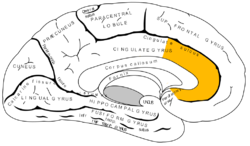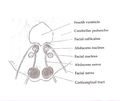In vision science, a saccade (/səˈkɑːd/ sə-KAHD; French: [sakad]; French for 'jerk') is a quick, simultaneous movement of both eyes between two or more...
29 KB (3,795 words) - 16:06, 13 April 2025
YJ-83 (redirect from CSS-N-8 Saccade)
pinyin: yingji-83; lit. 'eagle strike 83'; NATO reporting name: CSS-N-8 Saccade) is a Chinese subsonic anti-ship cruise missile. It is manufactured by...
17 KB (1,509 words) - 04:26, 9 April 2025
way that large changes in object location in the visual scene during a saccade or blink are not detected. The phenomenon described by Bridgeman et al...
4 KB (500 words) - 23:05, 18 April 2020
Antisaccade task (redirect from Anti-saccade Task)
The anti-saccade (AS) task is a way of measuring how well the frontal lobe of the brain can control the reflexive saccade, or eye movement. Saccadic eye...
9 KB (1,002 words) - 18:11, 22 October 2023
chronostasis, which momentarily occurs following a rapid eye-movement. A saccade is a fast eye motion, and because it is a motion that is optimised for...
12 KB (1,336 words) - 07:38, 14 March 2025
temporarily occurs when fixating on a target stimulus, immediately following a saccade (i.e., quick eye movement). This elicits an overestimation in the temporal...
17 KB (2,176 words) - 21:31, 24 March 2025
Eye movement in reading (section Saccades)
move continuously along a line of text, but make short, rapid movements (saccades) intermingled with short stops (fixations). Javal's observations were characterised...
19 KB (2,710 words) - 18:36, 8 September 2024
Transsaccadic memory (section Saccade target theory)
abruptly to the next point. Rapid eye movements of this type are called saccades. If a video camera were to perform such high speed changes in focal points...
26 KB (3,806 words) - 16:33, 18 December 2022
Eye movement (section Saccades)
movement to track objects of interest: smooth pursuit, vergence shifts and saccades. These types of movements appear to be initiated by a small cortical region...
29 KB (3,647 words) - 07:09, 26 January 2025
using a saccade task. Participants were shown a cue that indicated whether they had to make either a pro-saccade or an anti-saccade. An anti-saccade requires...
38 KB (4,618 words) - 05:45, 19 January 2025
from Congolese rumba. Soukous led to diverse offshoots, such as ekonda saccadé, reflecting the Mongo rhythmic influence, and mokonyonyon, emulating pelvic...
223 KB (21,352 words) - 11:21, 24 April 2025
oculomotor (cranial nerve III) nucleus to mediate conjugate horizontal gaze and saccades. The PPRF is situated in the pons just ventralmedial to the abducens nucleus...
8 KB (849 words) - 03:17, 19 March 2025
Rapid eye movement may refer to: Rapid eye movement sleep or REM sleep Saccade, a fast movement of an eye Rapid Eye Movement (album), an album by Riverside...
440 bytes (91 words) - 17:59, 19 April 2024
kava has been found to be free of association with reduced ability in saccade and cognitive tests, but has been associated with elevated liver enzymes...
72 KB (8,098 words) - 18:41, 22 April 2025
Frontal lobe injury (section Saccade)
when needed. A saccade is a fast movement of the eyes in a certain direction. In the most simplistic form, there are two types of saccade tests administered...
17 KB (2,158 words) - 02:04, 23 April 2025
Change blindness (section Saccade forcing paradigm)
continuous despite the shifting retinal input signal that accompanied each saccade. This research began when John Grimes and Dr. George McConkie (1996) began...
58 KB (7,204 words) - 21:49, 25 May 2024
Supplementary eye field (category Saccade)
Neural recordings in the SEF show signals related to both vision and saccades somewhat like the frontal eye fields and superior colliculus, but currently...
21 KB (2,492 words) - 09:30, 17 March 2025
Dual systems model (section Anti-saccade task)
inhibition tasks are the Go/No-Go, Flanker, Stroop, Stop Signal, and anti-saccade tasks. Individuals who perform well on these tasks generally activate the...
65 KB (7,672 words) - 16:57, 23 April 2025
turtles, salamanders, and owls. Regular eye movement alternates between saccades and visual fixations, the notable exception being in smooth pursuit, controlled...
24 KB (2,891 words) - 19:18, 3 December 2024
most likely involved in eye movement, as electrical stimulation evokes saccades (quick movements) of the eyes. It is also thought to contribute to working...
3 KB (355 words) - 20:18, 28 June 2023
movements. For saccades, neurons are activated in a region that represents the point to which the saccade will be directed. Just prior to a saccade, activity...
57 KB (7,267 words) - 13:56, 30 January 2025
music reading is the sequence of alternating saccades and fixations, as it is for most oculomotor tasks. Saccades are the rapid ‘flicks’ that move the eyes...
48 KB (7,188 words) - 11:49, 26 December 2023
the FEF induces monkeys to make a saccade to the relevant location. Stimulation at levels too low to induce a saccade will nonetheless enhance cortical...
105 KB (13,011 words) - 23:17, 22 April 2025
the reaction time associated with an increased number of elements, and saccade responses, where it was shown that there is either no relationship, or...
15 KB (1,820 words) - 12:53, 29 April 2024
Frontal eye fields (category Saccade)
saccadic eye movements. The FEF have a topographic structure and represents saccade targets in retinotopic coordinates. The frontal eye field is reported to...
7 KB (674 words) - 00:13, 25 January 2025
moving with velocities of greater than 30°/s tends to require catch-up saccades. Smooth pursuit is asymmetric: most humans and primates tend to be better...
20 KB (2,541 words) - 17:05, 9 December 2024
their eyes horizontally and moving them quickly. The main difficulty is in saccade initiation, but there is also impaired cancellation of the vestibulo-ocular...
14 KB (1,509 words) - 16:18, 11 February 2024
Videonystagmography (section Saccades)
v=rIcY_AdfYAk. Aspects analyzed are velocity gain, asymmetry, and phase angle. Saccades evaluate voluntary saccadic movement, which are quick eye movements to...
6 KB (668 words) - 11:23, 12 January 2025
(about 6.5 f-stops). As soon as the eye moves rapidly to acquire a target (saccades), it re-adjusts its exposure by adjusting the iris, which adjusts the size...
80 KB (9,524 words) - 10:27, 21 April 2025
previously assumed, but a series of short stops (called fixations) and quick saccades. This observation raised important questions about reading, questions which...
76 KB (9,150 words) - 00:09, 21 April 2025
















